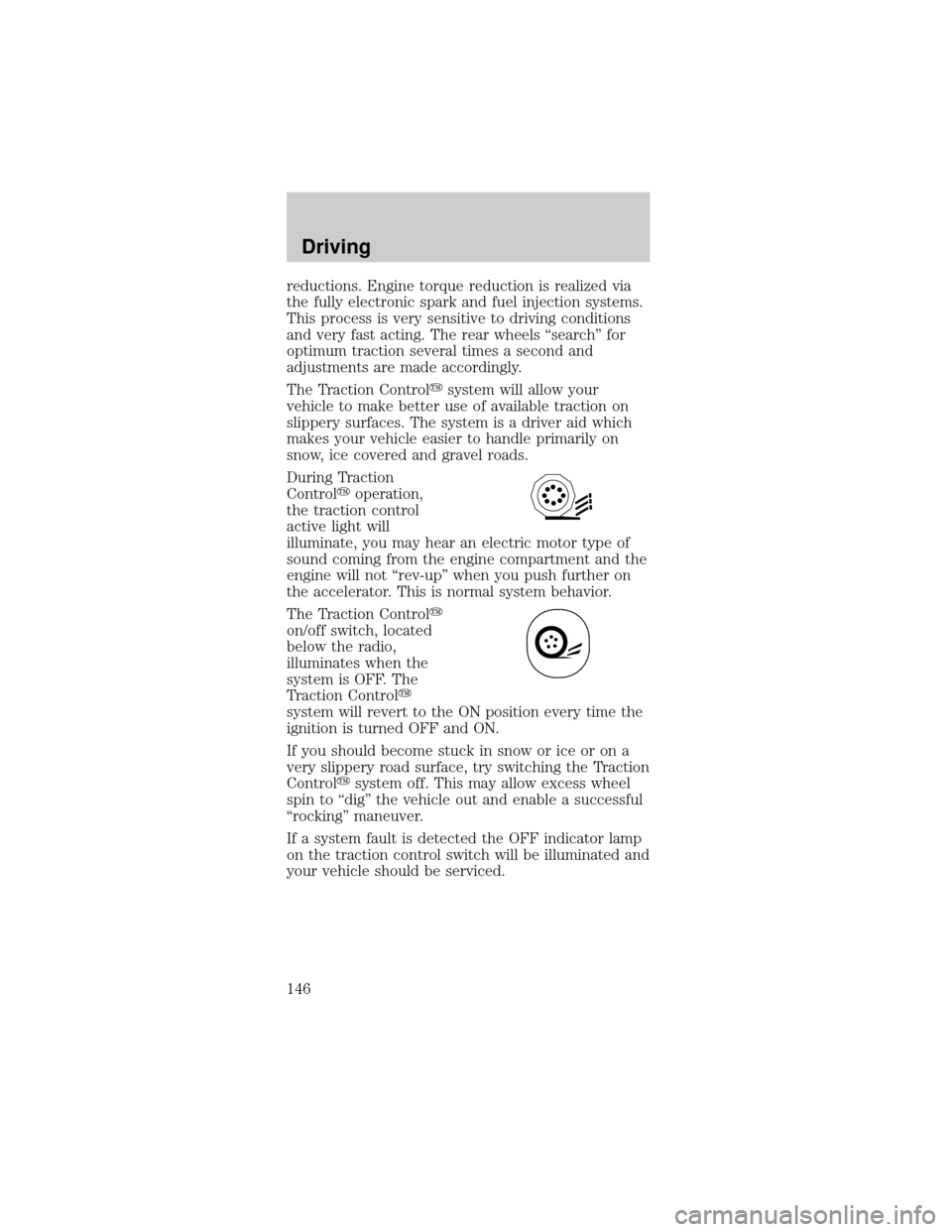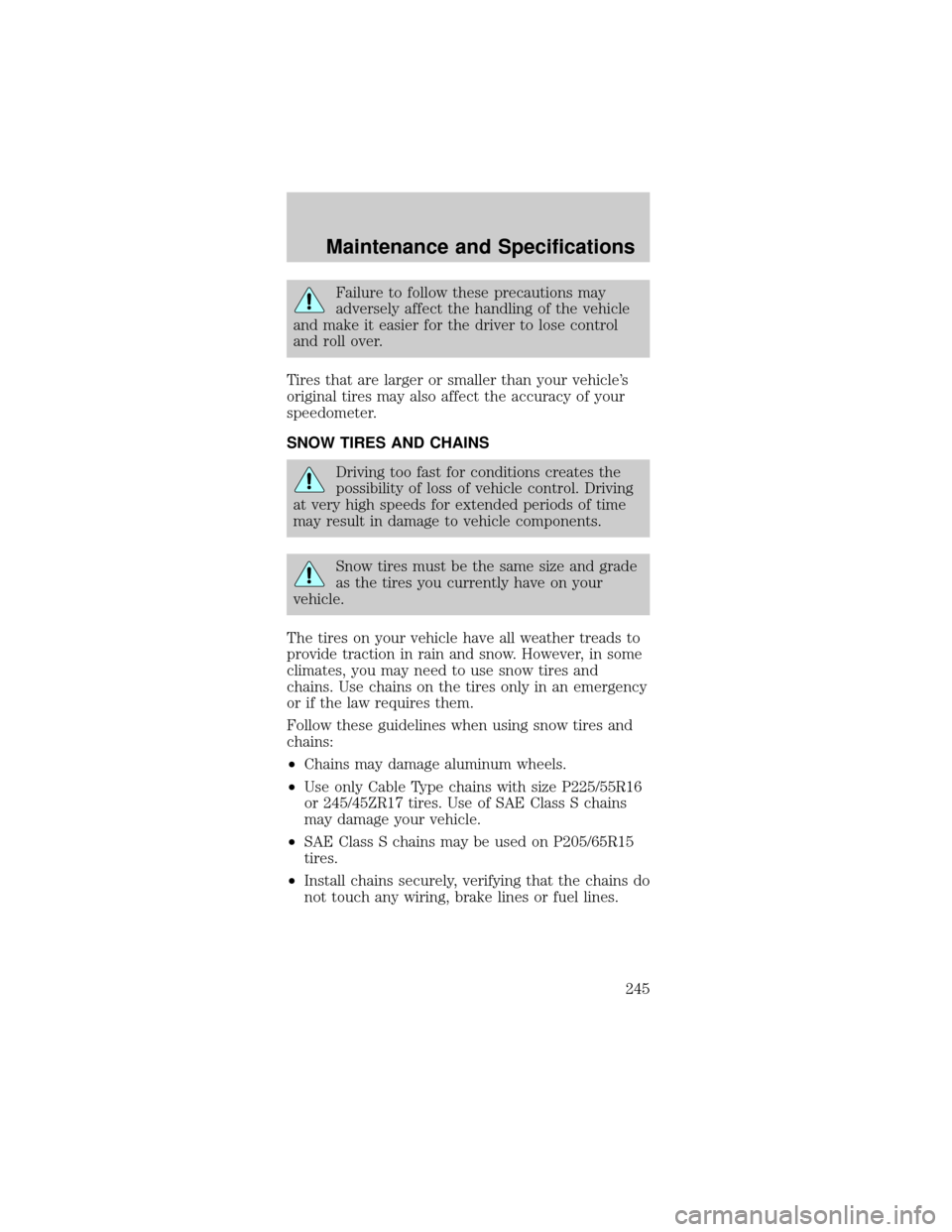2002 FORD MUSTANG fuel type
[x] Cancel search: fuel typePage 146 of 264

reductions. Engine torque reduction is realized via
the fully electronic spark and fuel injection systems.
This process is very sensitive to driving conditions
and very fast acting. The rear wheels ªsearchº for
optimum traction several times a second and
adjustments are made accordingly.
The Traction Controlysystem will allow your
vehicle to make better use of available traction on
slippery surfaces. The system is a driver aid which
makes your vehicle easier to handle primarily on
snow, ice covered and gravel roads.
During Traction
Controlyoperation,
the traction control
active light will
illuminate, you may hear an electric motor type of
sound coming from the engine compartment and the
engine will not ªrev-upº when you push further on
the accelerator. This is normal system behavior.
The Traction Controly
on/off switch, located
below the radio,
illuminates when the
system is OFF. The
Traction Controly
system will revert to the ON position every time the
ignition is turned OFF and ON.
If you should become stuck in snow or ice or on a
very slippery road surface, try switching the Traction
Controlysystem off. This may allow excess wheel
spin to ªdigº the vehicle out and enable a successful
ªrockingº maneuver.
If a system fault is detected the OFF indicator lamp
on the traction control switch will be illuminated and
your vehicle should be serviced.
Driving
146
Page 197 of 264

Do not clean the windshield or rear window
glass with abrasives, as they may cause
scratches.
Do not use fuel, kerosene, or paint thinner to
clean the windshield, rear window or the wiper
blades as damage may occur.
Clean the outside of the windshield or rear window
with a non-abrasive cleaner such as Ultra Clear Spray
Glass Cleaner (E4AZ-19C507±AA), available from your
authorized Ford, Lincoln or Mercury dealer. If after
cleaning the glass surface, the water sheets from the
glass (e.g., does not bead), then the window is clean.
The windshield, rear window and wiper blades should
be cleaned regularly. Wiper blades can be cleaned with
isopropyl (rubbing) alcohol or windshield washer
solution. Be sure to replace wiper blades when they
appear worn or do not function properly.
CONVERTIBLE TOP AND PADDED MOLDING
CARE
To avoid damage to the vinyl top and moldings, wash
with Triple Clean (EOAZ-19526±AA), which is
available from your authorized Ford, Lincoln or
Mercury dealer. Do not use stiff bristle brushes or
abrasive materials or cleaners.
Hot waxes applied by commercial car washes can
affect the cleanability of vinyl material.
Using high water pressure or wand-type car washes
against the convertible top and windows may cause
water leaks and possible seal damage.
CLEANING THE INSTRUMENT PANEL
Clean the instrument panel with a damp cloth, then
dry with a dry cloth.
Avoid cleaners or polish that increase the gloss of
the upper portion of the instrument panel. The dull
finish in this area helps protect the driver from
undesirable windshield reflection.
Cleaning
197
Page 229 of 264

Calculating fuel economy
1. Fill the fuel tank completely and record the initial
odometer reading (in kilometers or miles).
2. Each time you fill the tank, record the amount of
fuel added (in liters or gallons).
3. After at least three to five tank fill-ups, fill the
fuel tank and record the current odometer reading.
4. Subtract your initial odometer reading from the
current odometer reading.
5. Follow one of the simple calculations in order to
determine fuel economy:
Multiply liters used by 100, then divide by
total kilometers traveled.
Divide total miles traveled by total gallons
used.
Keep a record for at least one month and record the
type of driving (city or highway). This will provide
an accurate estimate of the vehicle's fuel economy
under current driving conditions. Additionally,
keeping records during summer and winter will show
how temperature impacts fuel economy. In general,
lower temperatures give lower fuel economy.
Driving style Ð good driving and fuel economy
habits
Give consideration to the lists that follow and you
may be able to change a number of variables and
improve your fuel economy.
Habits
²Smooth, moderate operation can yield up to 10%
savings in fuel.
²Steady speeds without stopping will usually give
the best fuel economy.
²Idling for long periods of time (greater than one
minute) may waste fuel.
Maintenance and Specifications
229
Page 230 of 264

²Anticipate stopping; slowing down may eliminate
the need to stop.
²Sudden or hard accelerations may reduce fuel
economy.
²Slow down gradually.
²Driving at reasonable speeds (traveling at 88 km/h
[55 mph] uses 15% less fuel than traveling at
105 km/h [65 mph]).
²Revving the engine before turning it off may
reduce fuel economy.
²Using the air conditioner or defroster may reduce
fuel economy.
²You may want to turn off the speed control in
hilly terrain if unnecessary shifting between third
and fourth gear occurs. Unnecessary shifting of
this type could result in reduced fuel economy.
²Warming up a vehicle on cold mornings is not
required and may reduce fuel economy.
²Resting your foot on the brake pedal while driving
may reduce fuel economy.
²Combine errands and minimize stop-and-go
driving.
Maintenance
²Keep tires properly inflated and use only
recommended size.
²Operating a vehicle with the wheels out of
alignment will reduce fuel economy.
²Use recommended engine oil. Refer toLubricant
specificationsin this chapter.
²Perform all regularly scheduled maintenance
items. Follow the recommended maintenance
schedule and owner maintenance checks found in
your vehicle scheduled maintenance guide.
Maintenance and Specifications
230
Page 245 of 264

Failure to follow these precautions may
adversely affect the handling of the vehicle
and make it easier for the driver to lose control
and roll over.
Tires that are larger or smaller than your vehicle's
original tires may also affect the accuracy of your
speedometer.
SNOW TIRES AND CHAINS
Driving too fast for conditions creates the
possibility of loss of vehicle control. Driving
at very high speeds for extended periods of time
may result in damage to vehicle components.
Snow tires must be the same size and grade
as the tires you currently have on your
vehicle.
The tires on your vehicle have all weather treads to
provide traction in rain and snow. However, in some
climates, you may need to use snow tires and
chains. Use chains on the tires only in an emergency
or if the law requires them.
Follow these guidelines when using snow tires and
chains:
²Chains may damage aluminum wheels.
²Use only Cable Type chains with size P225/55R16
or 245/45ZR17 tires. Use of SAE Class S chains
may damage your vehicle.
²SAE Class S chains may be used on P205/65R15
tires.
²Install chains securely, verifying that the chains do
not touch any wiring, brake lines or fuel lines.
Maintenance and Specifications
245
Page 248 of 264

Fluid Ford Part
NameApplication Capacity
Fuel tank N/A All 59.4L
(15.7 gallons)
Transmission
fluid
3Motorcraft
MERCONtV
AT FAutomatic
with 3.8L
OHV V6
engine13.1L
(13.9 quarts)
4
Automatic
with 4.6L
SOHC V8
engine12.0L
(12.8 quarts)
4
Motorcraft
MERCONt
AT FManual with
3.8L OHV V6
engine2.6L
(5.6 pints)5
Synthetic
MERCONt
AT FManual with
4.6L SOHC
V8 engine3.8L
(8.0 pints)5
Windshield
washer fluidUltra-Clear
Windshield
Washer
ConcentrateAll 3.8L
(4.0 quarts)
1Add the coolant type originally equipped in your
vehicle.
2Rear axle lubricants do not need to be checked or
changed unless a leak is suspected, service is
required or the axle assembly has been submerged
in water. The axle lubricant should be changed any
time the rear axle has been submerged in water. Fill
6 mm to 14 mm (1/4 inch to 9/16 inch) below
bottom of fill hole. Add 118 ml (4 oz.) of Additive
Friction Modifier C8AZ-19B546-A or equivalent
meeting Ford specification EST-M2C118±A for
complete refill of Traction-Lok axles.
3Ensure the correct automatic transmission fluid is
used. Transmission fluid requirements are indicated
on the dipstick or on the dipstick handle. MERCONt
and MERCONtV are not interchangeable. DO NOT
mix MERCONtand MERCONtV. Refer to your
scheduled maintenance guide to determine the
correct service interval.
Maintenance and Specifications
248